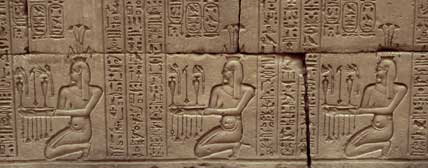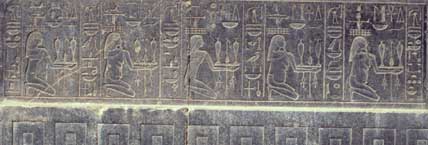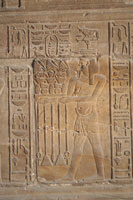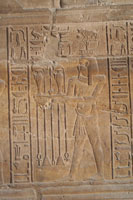|
Ancient
Egypt by Sjef Willockx |
||||||||||
|
In temples, we regularly find rows of symbolic figures that look exactly like the personifications of the Two Lands: generously proportioned, and with an identifying tuft of the heraldic plant on their head. They are however not engaged in the act of uniting the Two Lands, but shown presenting offerings.
Next is an example from much later date: the Ptolemaic Period (the last three centuries BC). It comes from the outer walls of the Opet temple at Karnak, next to the temple of Khons. The figures in this particular row all carry Lower Egypt’s papyrus plant on their heads. (The zigzags that evoke the water from which the plants sprout are visible on the 1st and 3rd.)
Again, the gifts that each of these figures brings are two water jars, with a scepter between them. Of each pair of jars, one is decorated with a lotus flower and bud, while the other has a papyrus flower and bud. Their appearing in a long row - much longer than is visible here - is characteristic: they come like supplicants, offering their gifts to the king.Because of the dominance of water in the symbolism, these characters are usually referred to as “Nile gods”. They are actually personifications of the Upper and Lower Egyptian Nile - but that makes for rather unwieldy nametags.
A closely related theme is that of the offering nomes. The example below is part of a long frieze on the lower end of the outer walls of the so-called Red Chapel of Hatshepsut: a reconstructed bark shrine, now in the Open Air museum at Karnak. The photograph shows - from right to left - the personifications of the 8th till 12th nome of Upper Egypt. The 10th and 12th nome are represented by a woman, because the names of these nomes are of feminine gender. This grammatical distinction was not always followed in the sex of the personifications.
The men in this row again closely resemble the
personifications of the Two Lands - having the same physique - but they
carry very different stuff on their heads. Each figure is identified
by
a “nome sign”: the “coat of arms” of a nome. Which means that these are
personifications of nomes (provinces).
So here, the notion that water equals sustenance is even more articulate.
|
|
|||||||||
|
|
All materials on this site are protected by copyright. All copyright by Sjef Willockx, unless otherwise indicated. |
|||||||||




